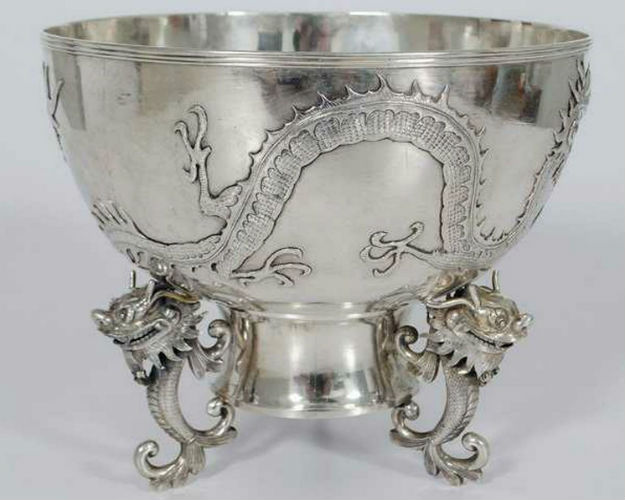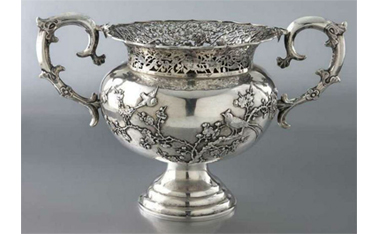
NEW YORK – In a roundabout way, the West’s demand for tea, spices and porcelain fostered the creation of Chinese export silver, luxurious pieces created exclusively for foreign markets.
When trade opened with the West in the late 1780s, sea captains, travelers and merchants arriving at Canton Port on clipper ships, were willing to purchase these precious commodities at any price. Since China’s entire economy and monetary systems had long been based on silver, however, that was the only currency the Chinese agreed to accept. They often smelted these profits into ingots.

Over time, this vast movement of silver from West to East affected global prices. As the price of silver rose in the West, it fell in China. In addition to an abundance of silver, highly skilled, inexpensive Chinese craftsmanship was readily available. Moreover, chinoiserie, a fashion featuring fanciful, Western interpretations of Chinese decorative arts, was sweeping Europe. Therefore, exporting Chinese silver creations was extremely profitable. Additionally, while waiting for favorable homebound winds, Westerners sometimes commissioned silver pieces for personal use or to peddle on the side.

During the First Chinese Export Silver Period, the early 1800s, Western clients preferred familiar, utilitarian English-style imported pieces. Since candlesticks, flatware, tea sets, tankards, and similar items were unknown in China, local artisans, all male, faithfully copied them from European prototypes. Though their results rivaled the best British silver in style and quality, these craftsmen evidently did not understand the significance of British hallmarks. In their passion to please, some unwittingly copied these as well, often with crude modifications. Since British hallmarking is highly regulated, many pieces bearing these pseudo-marks, considered fakes, were melted down. Only in the past 50 years have surviving pieces been recognized as rare examples of early Chinese Export silver.

During the Second Chinese Export Silver Period (1840-1880), international trading spread to Hong Kong and Shanghai. Although Western-style bowls, dishes and goblets remained popular, silversmiths eventually replaced restrained European designs with auspicious chased, repousse, or pierced Chinese images of bamboo, lotus blossoms, cherry blossoms, peonies and chrysanthemums.
Many craftsmen, working in small shops, completed their pieces with Chinese character silver marks, some combined with Latin initials. Others, possibly master artisans, stamped theirs with a variety of “chop marks,” character signs originally reserved for Imperial documents. Pieces bearing better-known chops, such as Kwong Wa, We We Wc, or Hung Chong, are extremely collectible. So are those bearing Wang Hing chops which, for over 20 years, identified Tiffany & Co. commissions. It is not known, however, if chops indicate individual craftsmen, specific workshops or, following Chinese tradition, were simply auspicious tradenames. Thus, the true identities of export silver creators may never be known.

During the Third Chinese Export Silver Period (1880s-1940), useful silver export pieces, like trinket boxes, belts, buckles, mugs and mustard pots, often featured detailed court or battle scenes in high ornamental relief. Others displayed more traditional motifs like foo (guardian) lions or the Three Star Immortals, which represent Happiness, Prosperity and Longevity.
Since Westerners frequently favored dragons, symbols of strength and Imperial power, many Chinese export silver pieces feature fanciful images of these fearsome beasts. Those bearing three-dimensional, coiled, dragon-shaped handles, fine dragon-head finials or dragon-shaped pedestals are particularly desirable.

So are massive, stand-alone trophy urns once presented at races and regattas, especially if they include intriguing inscriptions. Large, showy punch bowls, claret jugs, trays and vases featuring crisp, detailed Chinese motifs and fine workmanship are extremely collectible as well.
“An item of Chinese Export Silver is never simply a piece of silver,” explains Adrien von Ferscht, leading expert in Chinese Export Silver, academician and consultant to museums world round. “It is a rich cultural narrative as well as being an item of beauty, immense craftsmanship and extraordinary creativity.”


